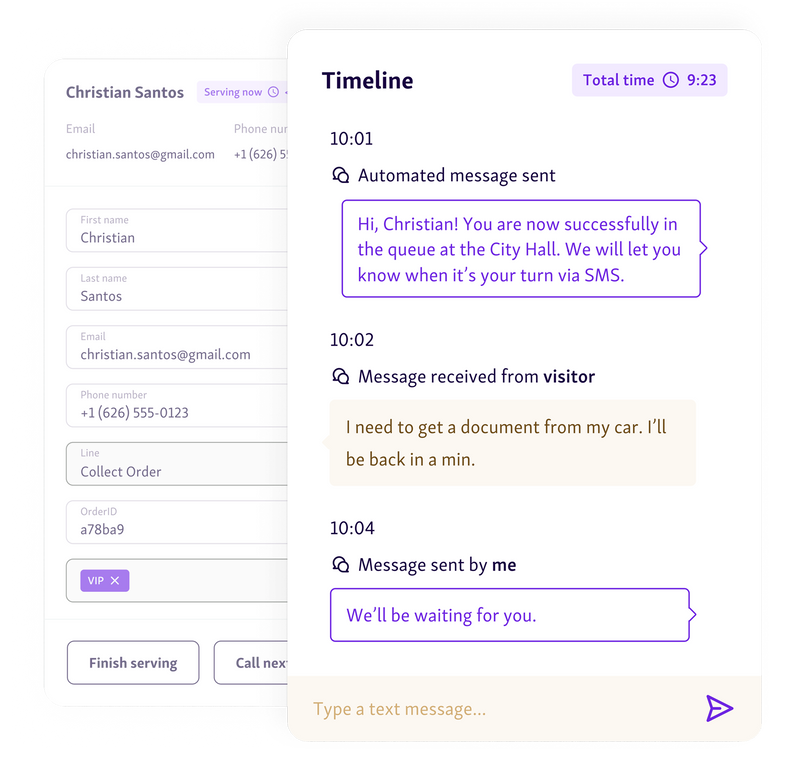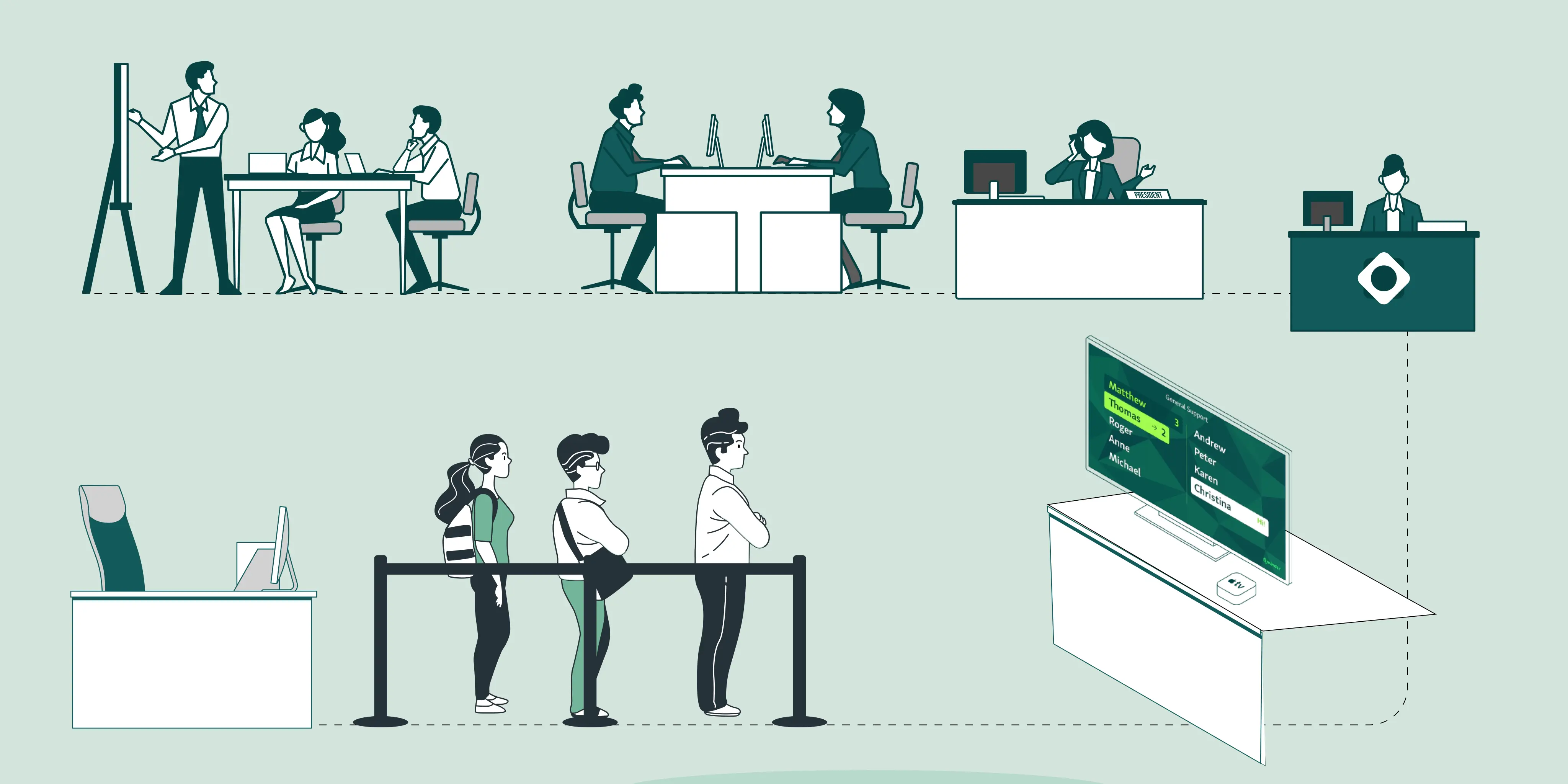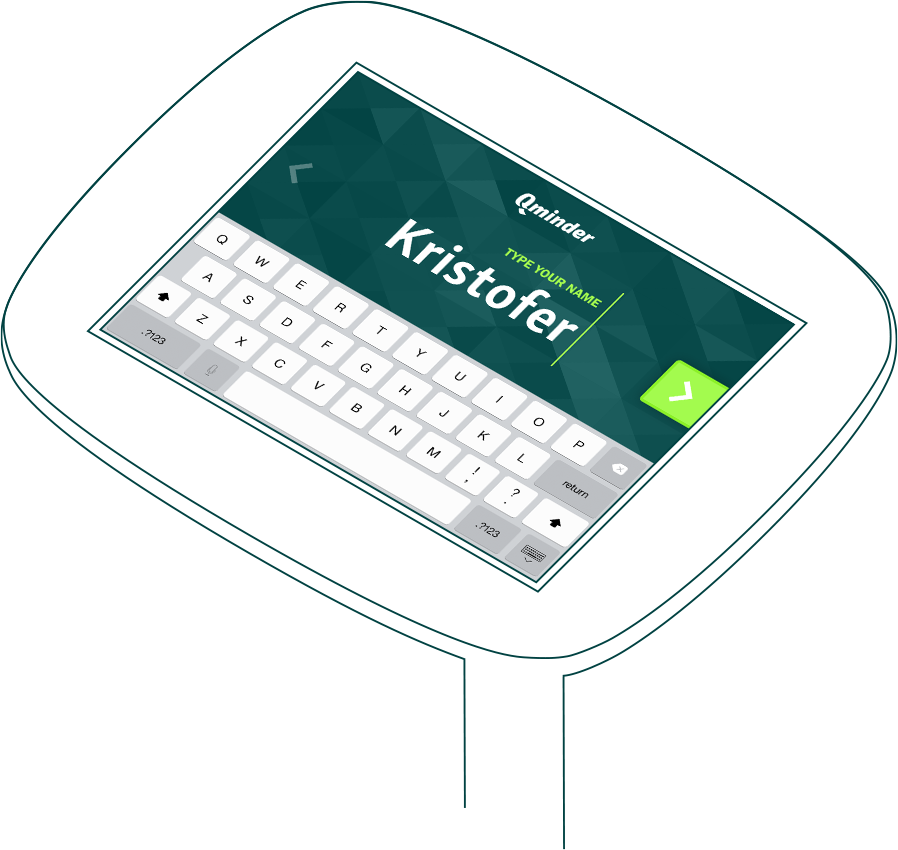The science of keeping queues moving — what we in the industry call queue management — is an integral part of business success. The faster and more efficient you can serve your customers, the better your revenue performance is.
Conversely, slow checkouts and long lines can scare customers away, rewarding your lack of effort with scathing reviews and bad public image.
So here’s a good question to ask yourself: which queues are better for managing visitors, single-line queues or multiple-line queues?
In this article, we’ll explain what each of these queue types does, what their pros and cons are, and give some recommendations on how to properly manage your queues.
Ready? Let’s dive in!
What is a single-line queue?
A single-line queue is the most straightforward type of queuing. The way it works is all in the name: it makes visitors stand in a single, serpentine line.
When the customer reaches the front of the line, they are called to one of the available service desks.
This is important to emphasize: single-line queues don’t mean one checkout point! There may be several working at the same time, but the way you get to them is by joining the queue and progressing forward.
Businesses that use single-line queues
There are many different types of businesses which employ single-line queuing. This kind of queue management speaks to the nature of the service these businesses are providing.
Let’s look over the companies that use single-line queues.
Restaurants
For the most part, restaurants serve customers on a first-come-first-seated basis. If a restaurant is particularly popular, you may even see a long line forming in the lobby.
All of the potential customers are told how much they need to wait before they can be seated. The earlier you got in the queue, the sooner you get the table.
There are exceptions, of course: some restaurants may offer tables to VIP customers, even if they’ve joined the queue later.
Transportation
You got a bus ticket, which you need to show to the bus driver to get your seat. There’s only one driver, so that means all of the passengers need to form an orderly queue and get their tickets looked at one by one.
Movie theatres
When you’re buying a movie ticket, there are usually several ticket booths to choose from. But when it’s time to show the ticket to the staff to get into the auditorium, that’s where single-line queuing kicks in.
Banks and government offices
When you want to (re)open a bank account or renew your driving license in DMV, you’re usually prompted to take a ticket at the entrance and wait for your number to show up. Don’t let multiple service points fool you: you’ve just joined a single virtual line.
What is a multiple-line queue?
A multiple-line queue works on the “more is better” understanding. Just like with single queues, there can be multiple service desks, but each comes with its own, separate line.
With the multiple-line approach, the queues look visually shorter as there’s more of them. However, with a separate line for each checkout point, there may be pressure on customers as to which line to join.
Businesses that use multiple-line queues
There are several reasons why a business would want to use multiple-line queues. But first, let’s see what exact businesses tend to employ such a queuing approach.
Supermarkets
When you’ve picked all the groceries on your shopping list and want to check out, you most probably see several different checkout lines and have to pick one to join.
Most supermarkets out there use the one-line-per-register system, which unwittingly creates anxiety in customers on whether they’ve chosen the “correct” line (but more on that later!).
Purchase of tickets
Be it a movie theatre, a fun fair, a bus depot or any other department where one would typically buy a ticket, there are usually several ticket booths/cashiers available. The lines to the booths run in parallel to each other, and each customer chooses the one that, as he feels, would result in shorter wait time.
Single queue vs Multiple queues: Which approach is better?
At the risk of sounding like some wishy-washy, “the truth is in the middle” hippies. Single-line queues promote fairness and reduce anxiety but can appear longer and take up more space, while multi-line queues feel faster and use space efficiently but may cause anxiety and line-switching.
When they’re both set up correctly, neither single-line queues nor multi-line queues are, strictly speaking, better.
It all comes down to what you expect from your queuing layout. To that end, let’s take a look at what either system has to offer, in terms of pros and cons.
Let’s start with a single-line queue:
Single-line queues promote fairness. They adhere quite strictly to the first-come-first-served approach, so line-jumping and line-cutting are not tolerated.
Single-line queuing helps avoid jockeying. Jockeying is a more official term for line-switching, which typically occurs when there are many queues to choose from.
As there’s only a single funnel to go through, there’s no anxiety as to whether you’ve joined the wrong queue. Customers in a single-line queue don’t feel tempted to switch to other lines.
But it’s not all shine and roses, though:
Single-line queues may lead to balking. A serpentine line stretches much longer than a multi-line queue, so researchers have noted that customers are more likely to balk at it.
Single-line queues take too much space. Richard Larson, a prominent queuing expert, has shared this anecdote: a hotel lobby was once “clogged” with queue researchers who decided to form a serpentine line to manage the visitor volume.
“The lobby wasn’t designed for it and it looked extremely messy. The hotel manager was unhappy. If we’d just dispersed into six parallel lines at the checkout desk the wait might have been shorter and less chaotic. But it would have been less fair.”
On the other hand:
Multi-line queues create a sense of speed. Unlike a serpentine queue, they deter balking, as customers who are dissatisfied with their progress in one queue, often switch to another.
Multiple-line queues use space more efficiently. The reasons why a single-line queue is also called “serpentine” is that it has to snake around obstacles to take the best advantage of the available space.
With multiple lines, even large crowds are more manageable and don’t hinder the foot traffic.
That’s as far as pros of multi-line queues go. Here are the cons:
There is a fear of joining the “wrong” queue. When there are multiple queues running at the same time, you often perceive the other queue to be moving faster than yours. This is what we call illusory correlation.
And this is why many customers every day experience the anxiety of having chosen the slower checkout lane.
Multiple-line queues encourage line-switching. This is connected to the previous point: when a customer is in rush, he or she may decide to ditch the queue they’ve been standing in and switch to another.
In practice, this rarely results in faster checkout, but does lead to momentary chaos, confusion and even altercations between customers.
What you need to manage single-line and multiple-line queues?
Whichever queuing approach you choose, it is only as good as your queue management equipment. It’s the 21st century, and digital technology is the way to go — in the matters of sales, customer service as well as queuing.
So here are three aspects of virtual queue management that can help you alleviate your queuing woes:
1. Centralized service dashboard
It is critical that the queue system that you employ could be operated at any time, from any place with an internet connection. When it comes to customer service, time is of essence: you need to react to any and all issues immediately.
A centralized dashboard gives you the tools to manage your visitors, and the bird’s eye view at how well your location is performing.
Qminder’s service dashboard allows you to manage and interact with visitors: see their previous service interactions with service staff, call them up for service, move them to a different line, or assign to a better-suited clerk.

On an administrative level, you can configure accounts, overview team and individual performance metrics, and manage access rights.
The ability to both serve visitors and access service metrics without switching to a different platform is a huge time-saver, and one of the top features any queue management system needs.
2. SMS notifications
To help keep customers informed about their queue status and progress, you need to take advantage of SMS texts as a method of two-way customer communication.
To read more about the benefits of SMS in the business context, see our article on why you should communicate with customers via SMS text messaging.

Here are the cliff notes:
With SMS, you can send out visit confirmations or wait time alerts.
You can use text messages as service/appointment reminders (this helps reduce the number of no-shows).
You can share updates about delays, cancellations, postponement, additional requirements, etc. so that your customer would always be up to speed.
Integrating online queue systems with SMS messaging is more than a nice perk to have. Going forward, it is nothing short of a necessity.
3. Service data analysis
We’ve underscored the importance of customer service analytics, times and times again. We even coined the term “service intelligence”, which refers to improving your customer service’s level of quality through actionable data.
And the best way to get this data is with the help of an online queuing system.

A customer queue system with data analytics gives you valuable insights into:
Customer behavior: which service they seek out the most, how often they walk away, how many no-shows you get, their history of service interactions, etc.
Service performance metrics: average wait time, servicing time, queue length and everything else you need to know to make your service better.
Employee performance: who services the most visitors, which employee needs to be rewarded for overperforming or get additional training due to falling behind.
You can dive even deeper to explore every facet of your customer service design. Then, you export your findings into neat reports, which are ideal for business meetings.
When you have the right data, you can make informed business decisions.






